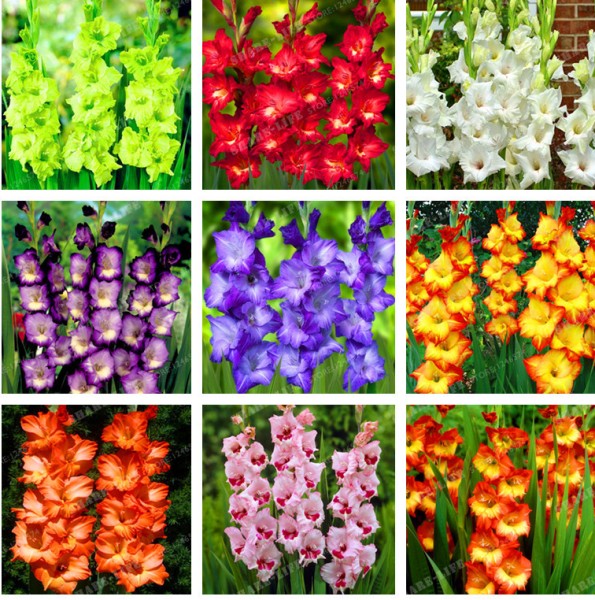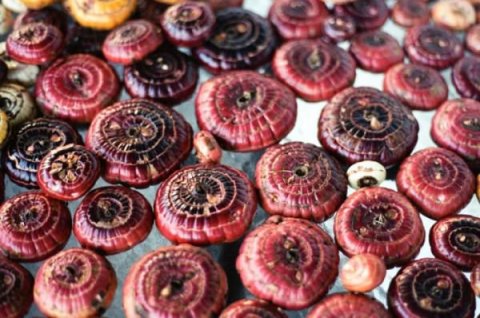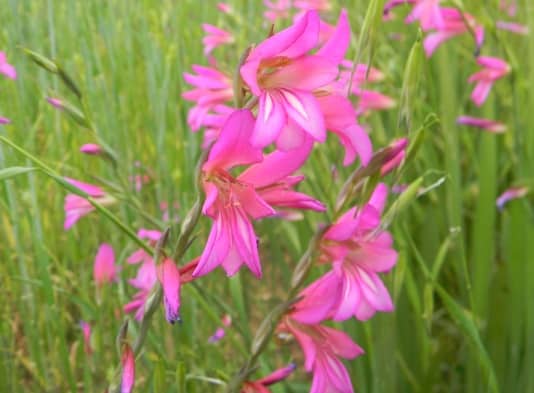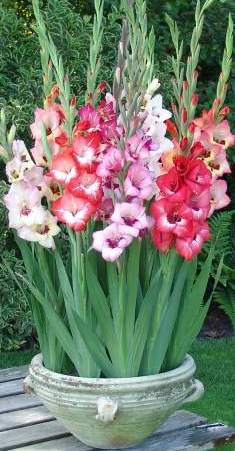Gladiolus Growing for Beginners:
Introduction to Gladiolus Growing:- It is a herbaceous plant bearing underground storage stalks called corms by which arise sword-shaped foliage bearing terminal inflorescences of flowers called spikes. These blossoms are originated from Tropical and South Africa. It is sometimes known as the ‘sword lily’, however, is generally called by its generic title gladioli. Gladiolus is a genus of perennial cormous flowering plants in the iris family of Iridaceae. Their stalks are normally unbranched, producing 1 to 9 narrow, sword-shaped, longitudinal grooved leaves, included in a sheath. The smallest foliage is shortened to a cataphyll. The leaf blades could be airplane or cruciform in cross-section. The flower spikes are big and one-sided, with secund, bisexual blossoms, each subtended by two leathery, green bracts. The Gladiolus flowers are variously colored, ranging from pink to reddish or light purple with white, contrasting markings, or white to orange or cream to crimson. Commercial Cultivation of Gladiolus is increasing since trimming blossoms demand is also increasing. You can grow Gladiolus flowers in pots, containers, backyards, greenhouse, and polyhouse.
Scientific Name / Botanical Name of Gladiolus:- Gladiolus communis.
Family Name of Gladiolus:- Iridaceae.
Genus of Gladiolus:- Gladiolus.
Common Names of Gladiolus:- Gladiolus, Gladiole, Gladioluses, Gladioli, Sword Lily, Corn Lily, Natal lily, Dragon’s head lily, Parrot lily, and African gladiolus.
Varieties / Types (Cultivars) of Gladiolus:- There are many improved/hybrid varieties grown across the globe. You should find out with your local horticulture department for a suitable commercial variety of Gladiolus flowers. However, the following are some of the common varieties grown in Indian region: Tropic Sea, White Prosperity, Priscilla, Summer Sunshine, Pusa Swarnima, Jackson Ville Gold, KKL.1, Archana, Basant Bahar, Indrani, Kalima, Kohra, Aarti, Arka Kesar, Darshan, Dhiraj, Agnirekha, Archana, Bindiya, and Shree Ganesh.

Pollination Gladiolus:- Cross / Self-pollinated.
Climate Requirement for Gladiolus Growing:- Gladiolus prefers mild climate and sunny situation due to their proper growth and flowering. Temperature is considered as a significant factor influencing a number of days required for flowering. Optimum growth of gladioli happens at temperatures between 10°C and 25°C at which the night temperature is not over 15°C. But these plants may tolerate temperature up to 40°C only if the relative humidity is high and soil moisture levels are optimum. Light levels influence initiation of the flowers. The period of flower initiation commences when the third leaf becomes visible and ends whenever the sixth and seventh foliage looks. Quality of flower spikes and yield is greater in a very long day condition than short days. Minimum illumination of 8 hours/day is essential for a lot of the gladiolus varieties (cultivars).
Soil Requirement for Gladiolus Growing:- Gladiolus generates the best spikes when developed in deep, well-drained sandy loam soils. A heavy clay soil, with inadequate drainage, is unfit because the gladiolus root process is easily ruined by excessive soil moisture and water stagnation. But, mixing of 5 to 8 cm thick layer of river sand together with the manure will produce the clay soil cultivable. For best development, they require slightly acidic soil of approximately pH 6.0 to 7.0 in which nearly all of the nutrients become available to the crops.
Land Preparation for Gladiolus Growing:- The soil must be completely ploughed 30 to 45 cm deep and exposed to sunlight for at least for 3 weeks. After removing the weeds, the field ought to be re-ploughed and levelled. If green manuring harvest is taken it ought to be turned down into the soil at least 15 days before planting of corms. Animal manure is not suggested since it is a source of germs. Ridges and furrows should be ready according to the spacing recommended.
Propagation in Gladiolus Growing:- Commercial crop propagation is done through corms. By way of multiplying the planting stock, it is advisable and cheaper to use Cormels. They’re produced in clusters on stolons between mother and daughter corms. Cormels are chosen carefully to prevent the spreading of disease. Hot water treatment or water soaking for four to eight days facilitates early and uniform sprouting (germination). Cold storage of corms at 3°C to 7°C for 90 to 100 days or treatment with Ethrel (1000 ppm) should be adopted for breaking corm dormancy.

Swelling of origin in the bottom indicates that Cormels are prepared for planting. Most Cormels are implanted at a depth of 5 cm and in rows, 10 to 13 cm wide furrows, spaced 60 to 75 cm apart. Approximately 130 large Cormels may be planted for each meter of row. Sprouting takes place within one to three weeks time from the date of planting, depending upon the size of their corms. Flowering size corms are obtained within 1 to 3 years after planting the Cormels.
Season for Gladiolus Growing:- Gladiolus flowers can be grown throughout the year under ideal irrigated conditions. This harvest requires minimum 10 to 11 hours of sunlight to overcome blindness. So season ought to be corrected or light substitution ought to be given.
Planting and Spacing for Gladiolus Growing:- Usually, corms are planted 8-15 cm deep at a spacing of 15 to 30 cm x 30 to 40 cm, depending on the size of corms. A plant population of 15/sq. M or 1,50,000/ha is ideal for the quality production of flower spikes and corms. The soil must have sufficient moisture prior to planting so that no watering is required till sprouting. Each cultivar has a fairly definite number of days to blossom, ranging from 60-69 days, 70 to 75 days, 80 to 85 Days, and 100 days or longer, early, early mid-season, mid-season, overdue and very late cultivars, respectively.
The size of the corms has a positive correlation with the height of the spike and number of florets per spike. Medium-sized corms of 4 to 5 cm diameter each are selected for planting to obtain quality blooms and uniform flowering. The bigger corms called ‘Jumbo’, 6 to 8 cm diameter, are good for getting top quality spikes for exhibition purposes. Smaller corms, of 2 to 5 cm diameter each can also be planted as flowering stock but corms and Cormels having a diameter less than 2.5 cm are mainly used as a planting stock in the nursery for development of bigger corms for next year planting.

Irrigation for Gladiolus Growing:- Sufficient water is required for good development of gladiolus. The amount of irrigation depends on the climate and type of soil. Normally, 1 to 2 irrigation per week is sufficient. Irrigation is provided immediately after the application of fertilizers and during the emergence of buds. Watering should be stopped at the time of ripening of corms. Irrigate at 7 to 8 days intervals in sandy soils and in less regular intervals in heavy soils. Irrigation should be withheld at least 4 to 6 weeks before the lifting of corms.
Intercultural Operations in Gladiolus Growing:- Timely Intercultural operations in the flower orchard is essential for healthy plants.
- Weed Control: The field should be kept clean by regular weeding and hoeing. When the area is small, weeding and hoeing should be done manually. First, weeding is completed within three weeks after sowing while the next weeding is done before application of fertilizer as a top dressing.
- Earthling Up: Earthling up should be practiced when the soil is heavy and deep planting is not possible. It is done when the plants are 20-30 cm in height. The tall plants are staked. Staking is done after the development of spikes but before the opening of florets. Plants are loosely secured at three places with the help of jute cord.
- Mulching: Mulching with sterile grass will help to conserve the moisture and suppress the weed growth. However, this Practice ought to be discouraged in fields infested with termites.
Manures and Fertilizers for Gladiolus Growing:- Application of fertilizer leads to the formation of healthy and large-sized corms, which give large-sized flowers on long spikes during the succeeding year. Must only be applied for a preceding crop rather than before planting gladioli. Application of fertilizer use should be determined by soil analysis. Normally 120 kg of N, 150 kg of P2O5 and 150 Kg of K2O per hectare are advocated, of which 60 kg of nitrogen (‘N’) and entire dosages of P2O5 and K2O ought to be applied as basal dose. The balance of ‘N’ should be given in 2 split doses, one as the foliar spray at a 4 leaf point while the moment as soil application at the bud stage.

Pests Diseases in Gladiolus Growing:- The following are diseases found in Gladiolus Growing.
- Pests in Gladiolus Growing: Thrips, Cut Worms, Leaf Eating Caterpillar, Mites, Mealy Bug, Root-knot Nematode and Rodents are common pests found in Gladiolus Growing. For Symptoms and control measures, contact your local horticulture department.
- Diseases in Gladiolus Growing: Botrytis Soft Rot, Fusarium Corm Rot, Penicillium Rot, and Tip Burn are common diseases found in Gladiolus growing. For Control measures and symptoms, visit nearest horticulture department or any agriculture professional.
Note: Your local department of horticulture or agriculture is a good source for finding information about pests and diseases in Gladiolus Growing. Don’t experiment on your own without knowing the symptoms and causes.
Harvesting in Gladiolus Growing:- Gladiolus requires 4 months to create spikes. While harvesting, at least four basal leaves must be retained on the plant to ensure the appropriate growth of corms and Cormels. Gladiolus spikes are ready for harvesting when the first bud indicates the color of this variety. Ordinarily, the early varieties start producing spikes out of 75 days while the late-season varieties in 85-90 day following planting Spikes must be trimmed in the tight bud stage, with one or two pairs of leaves along with 1 to 3 floral buds showing shade. The plant ought to be left with 3 to 5 leaves around the stem because of the evolution of new corms and Cormels. If the spikes are to be utilized as new blossoms, then they need to be trimmed with 3-4 open florets, but without any sign of withering. Slant cut ought to be given at the bottom of the chosen spikes and immediately put in a bucket with cold water.
Post-Harvesting of Gladiolus:- Soak the stem in water to avoid wilting and lodging of stem and flower. Based on stem length and quantity of florets, the spikes are grouped into A, B, C, and D grades.
Yield in Gladiolus Growing:- Well, the yield of this flower crop depends on many factors. The yield of flower spikes and corms in gladiolus is dependent upon variety (cultivar), corm size, planting density and garden management practices. Gladiolus planted at a spacing of 30 x 20 cm yields approximately 1,50,000 marketable spikes per hectare. Additional income can be obtained by the selling of approximately 3 lakh corms.
Marketing of Gladiolus:- Harvested cut flowers can be transported to local flower markets.
